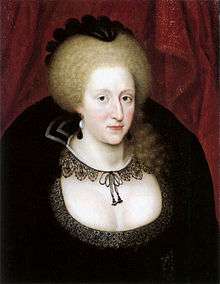Sign of Hertoghe
The Sign of Hertoghe or Queen Anne's sign is a thinning or loss of the outer third of the eyebrows, and is a classical sign of hypothyroidism or dermatitis atopica,[1][2] but it can also be detected in lepromatous leprosy.[3] The sign is named after Eugene Hertoghe of Antwerp, a pioneer in thyroid function research.[1][2]
Queen Anne's sign

Anne of Denmark mourning the death of her son Henry in 1612
The association with Anne of Denmark is based on portraiture, although history does not suggest that she suffered an underactive thyroid.[4] The eponym is disputed by some, though it has been suggested that Anne of France, Anne of Brittany, Anne of Austria, Anne Boleyn and Anne of Cleves may all be eliminated as candidates.[5]
References
- 1 2 Schatz, Henry A. (May 1922). "The Role of the Thyroid Gland in Otolaryngology". The Pennsylvania Medical Journal. 25 (8): 529.
- 1 2 "Complimentary Dinner given by Dr. William Seaman Bainbridge". American Medicine. 9 (4): 308. April 1914. Retrieved 2014-12-12.
- ↑ Parrino, Daniela; Di Bella, Stefano (2016-03-29). "Hertoghe sign: an hallmark of lepromatous leprosy". QJM: monthly journal of the Association of Physicians. doi:10.1093/qjmed/hcw046. ISSN 1460-2393. PMID 27026695.
- ↑ Lane Furdell E (May 2007). "Eponymous, anonymous: Queen Anne's sign and the misnaming of a symptom". J Med Biogr. 15 (2): 97–101. doi:10.1258/j.jmb.2007.06-13. PMID 17551609.
- ↑ Keynes, M (February 2009). "Letter to the editor". J Med Biogr. 17 (1): 62. doi:10.1258/jmb.2007.007021. PMID 19190203.
This article is issued from Wikipedia - version of the 11/8/2016. The text is available under the Creative Commons Attribution/Share Alike but additional terms may apply for the media files.